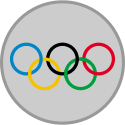Olympische Sommerspiele 1936/Rudern
| Rudern bei den Olympischen Sommerspielen 1936 | |
|---|---|
 | |
| Information | |
| Austragungsort | |
| Wettkampfstätte | Regattastrecke Berlin-Grünau |
| Nationen | 24 |
| Athleten | 314 (314 |
| Datum | 11.–14. August 1936 |
| Entscheidungen | 7 |
| ← 1932 Los Angeles | |
Bei den XI. Olympischen Sommerspielen 1936 in Berlin wurden sieben Wettbewerbe im Rudern auf der Regattastrecke Berlin-Grünau ausgetragen. In jeder Klasse konnte ein Boot pro Nation teilnehmen.
Bilanz
Medaillenspiegel
| Platz | Land | Gesamt | |||
|---|---|---|---|---|---|
| 1 | 5 | 1 | 1 | 7 | |
| 2 | 1 | 1 | – | 2 | |
| 3 | 1 | – | 1 | 2 | |
| 4 | – | 2 | – | 2 | |
| 5 | – | 1 | 1 | 2 | |
| 6 | – | 1 | – | 1 | |
| – | 1 | – | 1 | ||
| 8 | – | – | 2 | 2 | |
| 9 | – | – | 1 | 1 | |
| – | – | 1 | 1 | ||
| Gesamt | 7 | 7 | 7 | 21 | |
Medaillengewinner
| Disziplin | Gold | Silber | Bronze |
|---|---|---|---|
| Einer | |||
| Doppelzweier |
|
| |
| Zweier ohne Steuermann |
|
| |
| Zweier mit Steuermann |
|
| |
| Vierer ohne Steuermann |
| ||
| Vierer mit Steuermann |
| ||
| Achter |
|
|
Ergebnisse
| Platz | Land | Athlet | Zeit (min) |
|---|---|---|---|
| 1 | Gustav Schäfer | 8:21,5 | |
| 2 | Josef Hasenöhrl | 8:25,8 | |
| 3 | Daniel Barrow | 8:28,0 | |
| 4 | Charles Campbell | 8:35,0 | |
| 5 | Ernst Rufli | 8:38,9 | |
| 6 | Antonio Giorgio | 8:57,5 |
| Platz | Land | Athleten | Zeit (min) |
|---|---|---|---|
| 1 | Jack Beresford Leslie Southwood | 7:20,8 | |
| 2 | Willi Kaidel Joachim Pirsch | 7:26,2 | |
| 3 | Roger Verey Jerzy Ustupski | 7:36,2 | |
| 4 | André Giriat Robert Jacquet | 7:42,3 | |
| 5 | John Houser Bill Dugan | 7:44,8 | |
| 6 | Bill Dixon Herb Turner | 7:45,1 |
| Platz | Land | Athleten | Zeit (min) |
|---|---|---|---|
| 1 | Willi Eichhorn Hugo Strauß | 8:16,1 | |
| 2 | Harry Larsen Richard Olsen | 8:19,2 | |
| 3 | Horacio Podestá Julio Curatella | 8:23,0 | |
| 4 | Károly Győry Tibor Mamusich | 8:25,7 | |
| 5 | Wilhelm Klopfer Karl Müller | 8:33,0 | |
| 6 | Ryszard Borzuchowski Edward Kobyliński | 8:41,9 |
| Platz | Land | Athleten | Zeit (min) |
|---|---|---|---|
| 1 | Gerhard Gustmann Herbert Adamski Dieter Arend (Stm.) | 8:36,9 | |
| 2 | Almiro Bergamo Guido Santin Luciano Negrini (Stm.) | 8:49,7 | |
| 3 | Marceau Fourcade Georges Tapie Noël Vandernotte (Stm.) | 8:54,0 | |
| 4 | Remond Larsen Carl Berner Aage Jensen (Stm.) | 8:55,8 | |
| 5 | Georges Gschwind Hans Appenzeller Rolf Spring (Stm.) | 9:10,9 | |
| 6 | Ivo Fabris Elko Mrduljaš Pavao Ljubičić (Stm.) | 9:19,4 |
| Platz | Land | Athleten | Zeit (min) |
|---|---|---|---|
| 1 | Rudolf Eckstein Anton Rom Martin Karl Wilhelm Menne | 7:01,8 | |
| 2 | Martin Bristow Alan Barrett Peter Herbert Jackson John Sturrock | 7:06,5 | |
| 3 | Hermann Betschart Hans Homberger Alex Homberger Karl Schmid | 7:10,6 | |
| 4 | Antonio Ghiardello Luigi Luscardo Aldo Pellizzoni Francesco Pittaluga | 7:12,4 | |
| 5 | Rudolf Höpfler Camillo Winkler Wilhelm Pichler Hans Binder | 7:20,5 | |
| 6 | Knud Olsen Keld Karise Bjørner Drøger Emil Boje Jensen | 7:26,3 |
| Platz | Land | Athleten | Zeit (min) |
|---|---|---|---|
| 1 | Hans Maier Walter Volle Ernst Gaber Paul Söllner Fritz Bauer (Stm.) | 7:16,2 | |
| 2 | Hermann Betschart Hans Homberger Alex Homberger Karl Schmid Rolf Spring (Stm.) | 7:24,3 | |
| 3 | Fernand Vandernotte Marcel Vandernotte Jean Cosmat Marcel Chauvigné Noël Vandernotte (Stm.) | 7:33,3 | |
| 4 | Mak Schoorl Hotse Bartlema Flip Regout Simon de Wit Gerard Hallie (Stm.) | 7:34,7 | |
| 5 | Miklós Mihó Vilmos Éden Ákos Inotay Alajos Szilassy László Molnár (Stm.) | 7:35,6 | |
| 6 | Hans Mikkelsen Gunnar Ibsen Sørensen Flemming Jensen Svend Aage Holm Sørensen Aage Jensen (Stm.) | 7:40,4 |
| Platz | Land | Athleten | Zeit (min) |
|---|---|---|---|
| 1 | Herbert Morris, Charles Day, Gordon Adam, John White, Jim McMillin, George Hunt, Joseph Rantz, Don Hume, Robert Moch (Steuermann) | 6:25,4 | |
| 2 | Guglielmo Del Bimbo, Dino Barsotti, Oreste Grossi, Enzo Bartolini, Mario Checcacci, Dante Secchi, Ottorino Quaglierini, Enrico Garzelli, Cesare Milani (Steuermann) | 6:26,0 | |
| 3 | Alfred Rieck, Helmut Radach, Hans Kuschke, Heinz Kaufmann, Gerd Völs, Werner Loeckle, Hans-Joachim Hannemann, Herbert Schmidt, Wilhelm Mahlow (Steuermann) | 6:26,4 | |
| 4 | Tom Askwith, Ran Laurie, John Cherry, Hugh Mason, McAllister Lonnon, Annesley Kingsford, Desmond Kingsford, John Couchman, Noel Duckworth (Steuermann) | 6:30,1 | |
| 5 | Pál Domonkos, Sándor von Korompay, Hugó Ballya, Imre Kapossy, Antal Szendey, Gábor Alapy, Frigyes Hollósi, László Szabó, Ervin Kereszthy (Steuermann) | 6:30,3 | |
| 6 | Werner Schweizer, Fritz Feldmann, Rudolf Homberger, Oscar Neuenschwander, Hermann Betschart, Hans Homberger, Alex Homberger, Karl Schmid, Rolf Spring (Steuermann) | 6:35,8 |
Literatur
- Volker Kluge: Olympische Sommerspiele. Die Chronik I. Athen 1896 – Berlin 1936. Sportverlag Berlin, Berlin 1997, ISBN 3-328-00715-6, S. 855–859.
- Daniel James Brown: Das Wunder von Berlin. Riemann Verlag, München 2015, ISBN 978-3-570-50184-9 (Im Original: The Boys in the Boat. Viking, Penguin Group New York 2013)
Weblinks
Auf dieser Seite verwendete Medien
Pictograms of Olympic sports - Rowing. This is unofficial sample picture. Images of official Olympic pictograms for 1948 Summer Olympics and all Summer Olympics since 1964 can be found in corresponding Official Reports.
National- und Handelsflagge des Deutschen Reiches von 1935 bis 1945, zugleich Gösch der Kriegsschiffe.
Das Hakenkreuz ist im Vergleich zur Parteiflagge der NSDAP um 1/20 zum Mast hin versetzt.
National- und Handelsflagge des Deutschen Reiches von 1935 bis 1945, zugleich Gösch der Kriegsschiffe.
Das Hakenkreuz ist im Vergleich zur Parteiflagge der NSDAP um 1/20 zum Mast hin versetzt.
Autor/Urheber: Kwamikagami, Lizenz: CC BY-SA 4.0
symbol of Mars. 16 × 16 pixel nominal dimensions, lines 2 pixel thick, square caps. Colour 75% blue: red=0 green=0 blue=191 (#0000BF).
Autor/Urheber: Kwamikagami, Lizenz: CC BY-SA 4.0
symbol of Mars. 16 × 16 pixel nominal dimensions, lines 2 pixel thick, square caps. Colour 75% blue: red=0 green=0 blue=191 (#0000BF).
Autor/Urheber: maix¿?, Lizenz: CC BY-SA 2.5
A gold medal with the olympic rings inside
Autor/Urheber: maix¿?, Lizenz: CC BY-SA 2.5
A silver medal with the olympic rings inside
Autor/Urheber: maix¿?, Lizenz: CC BY-SA 2.5
A bronze medal with the olympic rings inside
Flagge des Vereinigten Königreichs in der Proportion 3:5, ausschließlich an Land verwendet. Auf See beträgt das richtige Verhältnis 1:2.
Flagge des Vereinigten Königreichs in der Proportion 3:5, ausschließlich an Land verwendet. Auf See beträgt das richtige Verhältnis 1:2.
US Flag with 48 stars. In use for 47 years from July 4, 1912, to July 3, 1959.
Autor/Urheber: F l a n k e r, Lizenz: CC BY-SA 2.5
Flagge des Königreich Italiens (1861-1946) In einem staatlichem oder militärischem Kontext ist die Version mit der Krone zu verwenden.
Autor/Urheber: F l a n k e r, Lizenz: CC BY-SA 2.5
Flagge des Königreich Italiens (1861-1946) In einem staatlichem oder militärischem Kontext ist die Version mit der Krone zu verwenden.
Die quadratische Nationalfahne der Schweiz, in transparentem rechteckigem (2:3) Feld.
Flag of Second Polish Republic and later People's Republic of Poland in period from March 29, 1928 to March 10, 1980. Red shade used here is HTML "vermilion" #E34234. Proportion 5:8.
Flag of Second Polish Republic and later People's Republic of Poland in period from March 29, 1928 to March 10, 1980. Red shade used here is HTML "vermilion" #E34234. Proportion 5:8.
The Canadian Red Ensign used between 1921 and 1957.
This image has compared for accuracy (mainly colors) using an image from World Statesmen. The only change is making the maple leaves green from red. This image has compared for accuracy (mainly colors) using an image from World Statesmen. The most recent version of this image has changed the harp into one with a female figure; see [http://flagspot.net/flags/ca-1921.html FOTW
The Canadian Red Ensign used between 1921 and 1957.
This image has compared for accuracy (mainly colors) using an image from World Statesmen. The only change is making the maple leaves green from red. This image has compared for accuracy (mainly colors) using an image from World Statesmen. The most recent version of this image has changed the harp into one with a female figure; see [http://flagspot.net/flags/ca-1921.html FOTW
Flag of Australia, when congruence with this colour chart is required (i.e. when a "less bright" version is needed).
See Flag of Australia.svg for main file information.Flag of Hungary from 6 November 1915 to 29 November 1918 and from August 1919 until mid/late 1946.
Pan-Slavic flag. Emerged from 1848 Prague pan-Slavic conference, or interpretations of the resolutions of the conference. Drawn by Fibonacci.
Olympic Rings without "rims" (gaps between the rings), As used, eg. in the logos of the 2008 and 2016 Olympics. The colour scheme applied here was specified in 2023 guidelines.
Olympic Rings without "rims" (gaps between the rings), As used, eg. in the logos of the 2008 and 2016 Olympics. The colour scheme applied here was specified in 2023 guidelines.
Flag of Hungary from 6 November 1915 to 29 November 1918 and from August 1919 until mid/late 1946.
Pan-Slavic flag. Emerged from 1848 Prague pan-Slavic conference, or interpretations of the resolutions of the conference. Drawn by Fibonacci.
(c) David Liuzzo, CC BY-SA 3.0
State flag of Austria from 1934 to 1938.




















